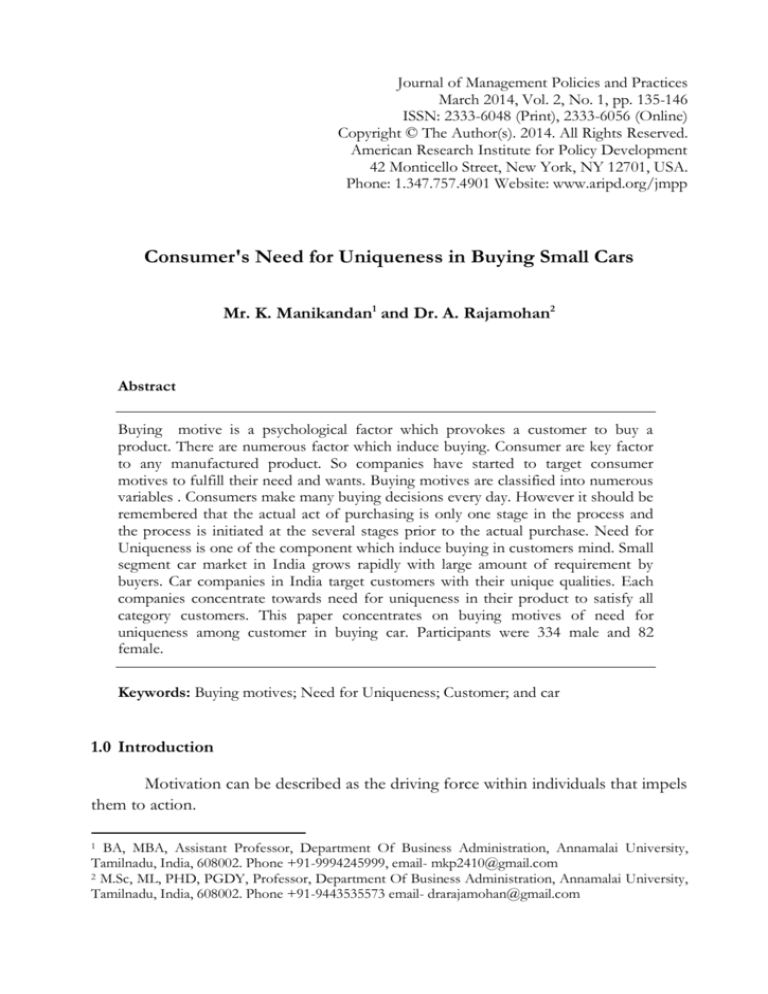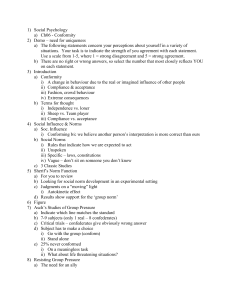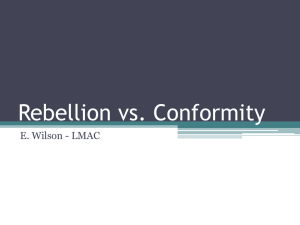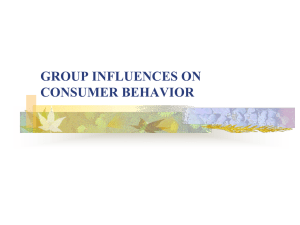
Journal of Management Policies and Practices
March 2014, Vol. 2, No. 1, pp. 135-146
ISSN: 2333-6048 (Print), 2333-6056 (Online)
Copyright © The Author(s). 2014. All Rights Reserved.
American Research Institute for Policy Development
42 Monticello Street, New York, NY 12701, USA.
Phone: 1.347.757.4901 Website: www.aripd.org/jmpp
Consumer's Need for Uniqueness in Buying Small Cars
Mr. K. Manikandan1 and Dr. A. Rajamohan2
Abstract
Buying motive is a psychological factor which provokes a customer to buy a
product. There are numerous factor which induce buying. Consumer are key factor
to any manufactured product. So companies have started to target consumer
motives to fulfill their need and wants. Buying motives are classified into numerous
variables . Consumers make many buying decisions every day. However it should be
remembered that the actual act of purchasing is only one stage in the process and
the process is initiated at the several stages prior to the actual purchase. Need for
Uniqueness is one of the component which induce buying in customers mind. Small
segment car market in India grows rapidly with large amount of requirement by
buyers. Car companies in India target customers with their unique qualities. Each
companies concentrate towards need for uniqueness in their product to satisfy all
category customers. This paper concentrates on buying motives of need for
uniqueness among customer in buying car. Participants were 334 male and 82
female.
Keywords: Buying motives; Need for Uniqueness; Customer; and car
1.0 Introduction
Motivation can be described as the driving force within individuals that impels
them to action.
1
BA, MBA, Assistant Professor, Department Of Business Administration, Annamalai University,
Tamilnadu, India, 608002. Phone +91-9994245999, email- mkp2410@gmail.com
2 M.Sc, ML, PHD, PGDY, Professor, Department Of Business Administration, Annamalai University,
Tamilnadu, India, 608002. Phone +91-9443535573 email- drarajamohan@gmail.com
136
Journal of Management Policies and Practices, Vol. 2(1), March 2014
This driving force is produced by state of tension, which exist as the result of
an unfilled need. Individuals strive both consciously and subconsciously to reduce this
tension through behaviour that anticipate which fulfill their needs and thus relieve
them of stress they feel. The specific goals they select and the patterns of action they
undertake to achieve their goals are the results of individual thinking and learning.
Every individual has needs; some are innate, others are acquired. Innate needs
are physiological; they include the need for food, for water, for air, for clothing, for
shelter, and for sex. Because they are need to sustain biological life, the biogenic needs
are considered primary needs or motives. Acquired needs are needs we learn in
response to our culture or environment. These may include need for esteem, for
prestige, for affection, for power and for learning. Because acquired needs are
generally psychological they are considered secondary need or motives. They result
from the individuals subjective psychological and from relationship with others. This
primary and secondary needs induce individuals to purchase goods and services.
1.1 Purchase Methods
The method of purchase depends upon the product to be purchased and
purchase intentions. The purchase can be fully planned, partially planned or
unplanned. The actual purchase and its effect on the consumer behaviour is the last
stage of consumer behaviour. The basic objective is to get satisfaction from a product
or service as anticipated. But in order that consumer gets result as expected or better
than his expectation depends upon method of purchase and process of purchase.
Fully Planned
Most of the purchase of consumer durables like TV., cars, refrigerators,
cooking range are fully planned. Similarly purchase of durables like house property,
insurance policy are fully planned. They are normally purchased after proper
evaluation.
Partially Planned
Manikandan & Rajamohan
137
In this category those item fall which consumer intent to buy but does not
make a shopping list before visiting the store/shop. In this group often the decision
on the quantity to be purchased and the brand to be purchased is decided by seeing
the price, the display of packing and the mood at the time of purchase.
Unplanned Purchase
Those purchase which are purchased spontaneously without prior planning
are called unplanned purchase. In such items advertisement, display, discount, sales
promotion schemes, free coupons, lottery gifts etc. Induce a customer to purchase
them when otherwise he has no intention to buy.
2.0 Buying Motives
Buying motives can be defined as all the impulse, desire and considerations,
which induce a buyer to purchase a given product. Buying motives are basically of two
kinds
1. Product motives
2. Patronage motives
The impulse, desire and considerations that make people buy a given product,
are called product motives. The impulse, desire and consideration that make people
buy from particular firm/shop are called patronage motives.
Product motives are of several types; and they can be classified in several ways. One
classification, that is linked to the nature of satisfaction sought by the buyer, puts
them into the following two categories:
1. Emotional motives
2. Rational motives
Another classification that takes into account the utility and prestige
dimensions of a product puts them into the following two categories.
1. Operational Product Motives
2. Socio-psychological Product Motives
138
Journal of Management Policies and Practices, Vol. 2(1), March 2014
Economical product motives are those impulse that appeal to the buyer's
pride or ego, his urge to imitate others, or his desire to be distinctive. The emotional
motives may persuade a consumer to buy a certain product without evaluating the
plus and minus points of such action. Careful reasoning or logical analysis need not be
found behind such purchases. Rational product motives, on the contrary, involve a
logical analysis of the intended purchase - the purpose expected to be served by the
product, the various alternatives available to the buyer, etc. Relevant and valid reasons
that justify the purchase are characteristics of rational product motives.
Consumers typically go through seven major stages when making decisions:
need recognition, search for information, pre-purchase evaluation, purchase,
consumption, post-consumption evaluation, and divestment. Though marketing
textbooks and consumer researchers sometime employ slightly different terms or
consolidate some of the stages, the study of consumer behaviour focuses primarily on
these seven stages and how various factors influence each stage of consumers
decisions. By understanding the stages in the consumer decision making road map,
marketers can discover why people are not buying products and what can be done to
get them to buy more or buy from a specific supplier.
3.0 Consumer Need for Uniqueness
People's motives for shopping are a function of many variables, some of
which are unrelated to the actual buying of products. It is maintained that an
understanding of shopping motives require the consideration of satisfactions which
shopping activities provide, as well as the utility obtained from the merchandise that
may be purchased. If needs other than those associated with particular products
motivate people to go to a store, the retailer should incorporate this information into
his marketing strategy. [Tauber, 1972].
Consumers' need for uniqueness is grounded in Snyder and Fromkin's (1980)
uniqueness theory, which manifests itself in the individual's pursuit of material goods
to differentiate themselves from others (Tian etal. , 2001).
Consumers' need for uniqueness is demonstrated in three types of consumer
behaviour :creative choice counter-conformity; unpopular choice counter-conformity;
and avoidance of similarity.
Manikandan & Rajamohan
139
In the first type of behaviour, creative choice counter-conformity, consumers
purchase goods that express their uniqueness and also are acceptable to others .Other
consumers willingly risk social disapproval to establish their uniqueness by selecting
products that deviate from group norms though unpopular choice counterconformity consumer behaviour (Tian et al. , 2001).
To avoid similarity with others, consumers may develop a variety of strategies.
For instance, they may purchase discontinued styles, shop in vintage stores, or
combine apparel in unusual ways.
In a study of the effects of social needs on conspicuous consumption,(
Amaldoss and Jain ,2005) found that consumers tended to purchase high-quality
products not because of their desire for uniqueness but despite it. The results of those
studies support the idea that consumers' brand perceptions are related to their need
for uniqueness.
Method
4.0 Participants
Participants were 334 male and 82 female business man, government employee,
private sector employee, farmer, professionals from Tamilnadu state in India. Age
group of respondents were calculated on the basis of 18-25=19.2,26-35=40.9,3645=27.9,46-55=12.0. Participants were told that the study measures the need for
uniqueness in buying small segment car.
4.1 Procedure
Definition of uniqueness for both markets is the same due to order of
importance for each constructs in mind of participants in the survey while this
definition remain the same between genders and among respondents with different
level of education.
Findings indicate that consumers want to express their individuality, and they
also want to maintain social norms (Knight, Dee K; Eun Young Kim, 2007). A selfadministered and consumer need for uniqueness questionnaire were circulated .
140
Journal of Management Policies and Practices, Vol. 2(1), March 2014
Each questionnaire consist of 45 questions that includes 14 demographic
variables and 31 items distributed as follows, creative choice counter conformity(11),
unpopular choice counter conformity(11), and avoidance of similarity(9) (Tian,
Bearden, and Hunter, 2001)
5.0 Results
In order to examine the significant difference among the respondents profile
and various dimensions of need for uniqueness, one way ANOVA were carried out
using SPSS.
Age Vs. Need for uniqueness
H0: There is no significant difference between the consumer need for uniqueness and
their age.
Table 1: Respondents opinion towards need for uniqueness dimensions based on their age
Consumer need for Age
uniqueness
Creative choice / Less than 25
counter conformity 26-35
36-45
Above 55
unpopular choice / Less than 25
counter conformity 26-35
36-45
Above 55
Avoidance of
Less than 25
similarity
26-35
36-45
Above 55
Mean
Std. Deviation
3.89
3.78
3.70
3.44
3.39
3.35
3.39
3.32
3.38
3.43
3.33
3.25
0.50
0.59
0.62
0.68
0.61
0.68
0.66
0.60
0.87
0.87
0.83
0.88
f-value
p-value
6.477
0.001* (S)
0.220
0.882(NS)
0.653
0.582(NS)
The creative choice / counter conformity mean value is ranged from 3.89 to
3.44. From the mean value it is observed that less than 25 years age group are more
interested over creative choice / counter conformity. The respondents who are in the
age group of above 55 are least interested on creative choice / counter conformity.
Manikandan & Rajamohan
141
From the ANOVA it is observed that f-value is 6.477 and the corresponding
p-value is 0.001. Hence there is significant difference in creative choice / counter
conformity based on their age.
The unpopular choice / counter conformity mean value is ranged from 3.39
to 3.32. From the mean value it is observed that age group less than 25 and 36 to 45
years age group are more interested over unpopular choice. The respondents who are
in the age group of above 55 are least interested on unpopular choice. The observed
f-value is 0.220 and the corresponding p-value is 0.882. Hence there is no significant
difference in unpopular choice with respect to age.
The mean value for avoidance of similarity ranges from 3.43 to 3.25. From the
mean value it is observed that 26 to 35 years age group are more interested over
avoidance of similarity. The respondents who are in the age group of above 55 are
least interested on avoidance of similarity. The observed f-value is 0.653 and the
corresponding p-value is 0.582. Hence there is no significant difference in avoidance
of similarity based on their age.
5.2 Education Vs. Need for Uniqueness
H0: There is no significant difference between the consumer need for uniqueness and
their education.
142
Journal of Management Policies and Practices, Vol. 2(1), March 2014
Table 2: Respondents opinion towards consumer need for uniqueness dimensions
based on their education
Consumer
Education
need for
uniqueness
Creative choice Primary education
Graduation
Pg
Others
Unpopular
Primary education
choice
Graduation
Pg
Others
Avoidance of Primary education
similarity
Graduation
Pg
Others
Mean
3.44
3.74
3.86
3.70
3.23
3.31
3.45
3.50
3.04
3.49
3.33
3.35
Std. Deviation
0.69
0.57
0.57
0.64
0.644
0.638
0.648
0.729
1.00
0.74
0.91
0.90
f-value
p-value
6.316
0.001(S)
2.525
0.057(S)
3.866
0.010(S)
The creative choice / counter conformity mean value is ranged from 3.86 to
3.44. From the mean value it is observed that post graduates are more interested over
creative choice / counter conformity. The primary education respondents are least
interested on creative choice / counter conformity. From the ANOVA it is observed
that f-value is 6.316 and the corresponding p-value is 0.001. Hence there is significant
difference in creative choice / counter conformity based on their education.
The unpopular choice / counter conformity mean value is ranged from 3.50
to 3.23. From the mean value it is observed that others category respondents are more
interested over unpopular choice / counter conformity. The primary education
respondents are least interested on unpopular choice / counter conformity. From the
ANOVA it is observed that f-value is 2.525 and the corresponding p-value is 0.057.
Hence there is significant difference in unpopular choice / counter conformity based
on their education.
Manikandan & Rajamohan
143
The avoidance of similarity mean value is ranged from 3.49 to 3.04. From the
mean value it is observed that graduation are more interested over avoidance of
similarity. The primary education respondents are least interested on avoidance of
similarity. From the ANOVA it is observed that f-value is 3.866 and the
corresponding p-value is 0.010. Hence there is significant difference in avoidance of
similarity based on their education.
5.3 Occupation Vs. Need for Uniqueness
H0: There is no significant difference between the consumer need for uniqueness and
their occupation.
Table 3: Respondents opinion towards consumer need for uniqueness dimensions
based on their occupation
Consumer
need for
uniqueness
creative
choice /
counter
conformity
Occupation
Mean
Business man
3.86
Government employee 3.58
Private sector employee 3.79
Agriculture
3.39
Professionals
3.76
unpopular
Business man
3.32
choice /
Government employee 3.30
counter
Private sector employee 3.33
conformity Agriculture
3.23
Professionals
3.51
Avoidance of Business man
3.48
similarity
Government employee 3.43
Private sector employee 3.49
Agriculture
2.96
Professionals
3.20
Std. Deviation f- value
0.40
0.62
0.60
0.86
0.55
0.69
0.58
0.56
0.62
0.79
0.76
0.88
0.78
0.97
0.94
p- value
4.503
0.001*(S)
1.880
0.113(NS)
4.176
0.003**(S)
The creative choice / counter conformity mean value is ranged from 3.86 to
3.39. From the mean value it is observed that business man are more interested over
creative choice / counter conformity.
144
Journal of Management Policies and Practices, Vol. 2(1), March 2014
The respondents who are agriculture are least interested on creative choice /
counter conformity. From the ANOVA it is observed that f-value is 4.503 and the
corresponding p-value is 0.001. Hence there is significant difference in creative choice
/ counter conformity based on their occupation.
The unpopular choice / counter conformity mean value is ranged from 3.51
to 3.23. From the mean value it is observed that professionals are more interested
over unpopular choice / counter conformity. The respondents who are agriculture are
least interested on unpopular choice / counter conformity. From the ANOVA it is
observed that f-value is 1.880 and the corresponding p-value is 0.113. Hence there is
no significant difference in unpopular choice / counter conformity based on their
occupation.
The avoidance of similarity mean value is ranged from 3.49 to 2.96. From the
mean value it is observed that private sector employee are more interested over
avoidance of similarity. The respondents who are agriculture are least interested on
avoidance of similarity. From the ANOVA it is observed that f-value is 4.176 and the
corresponding p-value is 0.003. Hence there is significant difference in avoidance of
similarity based on their occupation.
5.4 Brand Vs. Need for Uniqueness
H0: There is no significant difference between the consumer need for uniqueness and
brand.
Manikandan & Rajamohan
145
Table 4: Respondents opinion towards consumer need for uniqueness dimensions
based on their owning which small segment car company
Consumer
need for
uniqueness
creative choice
/ counter
conformity
unpopular
choice /
counter
conformity
Owning which
small segment car
company
Maruthi
Ford
Tata
Hyundai
Others
Maruthi
Ford
Tata
Hyundai
Others
Avoidance of Maruthi
similarity
Ford
Tata
Hyundai
Others
Mean
Std. Deviation
3.70
3.77
3.80
3.76
3.38
0.65
0.53
0.60
0.58
0.73
3.24
3.41
3.46
3.38
3.30
3.30
3.53
3.38
3.49
2.55
0.63
0.57
0.71
0.67
0.58
0.83
0.69
0.92
0.84
0.92
f- value
p- value
2.140
0.075(NS)
1.678
0.154(NS)
5.861
0.001*(S)
The creative choice / counter conformity mean value is ranged from 3.80 to
3.38. From the mean value it is observed that respondents owning Tata are more
interested over creative choice / counter conformity. The respondents owning other
small segment car are least interested on creative choice / counter conformity. From
the ANOVA it is observed that f-value is 2.140 and the corresponding p-value is
0.075. Hence there is no significant difference in creative choice / counter conformity
based on their owning which small segment car company.
The unpopular choice / counter conformity mean value is ranged from 3.46
to 3.24. From the mean value it is observed that respondents owning Tata are more
interested over unpopular choice / counter conformity. The respondents owning
Maruthi are least interested on unpopular choice / counter conformity.
146
Journal of Management Policies and Practices, Vol. 2(1), March 2014
From the ANOVA it is observed that f-value is 1.678 and the corresponding
p-value is 0.154. Hence there is no significant difference in unpopular choice /
counter conformity based on their owning which small segment car company.
The avoidance of similarity mean value is ranged from 3.53 to 2.55. From the
mean value it is observed that respondents owning Ford are more interested over
avoidance of similarity. The respondents owning other small segment car are least
interested on avoidance of similarity. From the ANOVA it is observed that f-value is
5.861 and the corresponding p-value is 0.001. Hence there is significant difference in
avoidance of similarity based on their owning which small segment car company.
6.0 Conclusion
This study reveals the value of consumer need for uniqueness among small segment
car buyers. This study focuses on customer purchase intention towards their
uniqueness need. Creative choice / counter conformity respondents are having higher
level of interest on TATA companies car. Unpopular choice/counter conformity
respondents are also having higher level of interest on TATA companies car.
Avoidance of similarity respondents are having higher level of interest towards Ford
companies car.
7.0 Reference
Amaldoss, W. and Jain, S. (2005), "Pricing of conspicuous goods: a competitive analysis of
social effects", Journal of Marketing, Vol. 42, pp. 30-42.
Consumer behaviour Roger D. Blackwell Paul W. Miniard James F. Engel cengage learning
3rd 2009,
Consumer behaviour in Indian context PC JAIN& Monika bhatt s chand publication 2003
1st edition.
Consumer Behaviour Leon g schiffman & leslie lazar kanuk 3rd prentice hall of India
Research methodology C R Kothari 2nd wishwa prakashan 2002
Marketing management V S Ramaswamy& S Namakumari 4th 2009 macmillan
Tian, K.T., Bearden, W.O. and Hunter, G.L. (2001), "Consumers' need for uniqueness: scale
development and validation", Journal of Consumer Research, Vol. 28 No. 2, pp. 5066.









